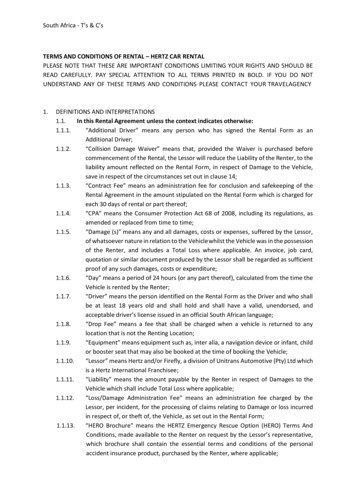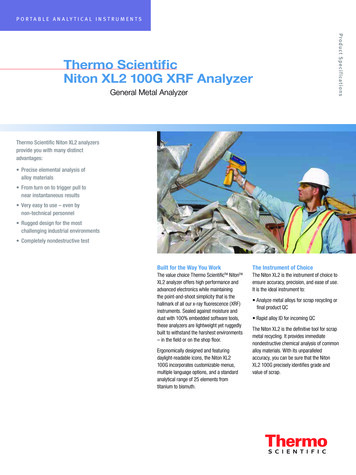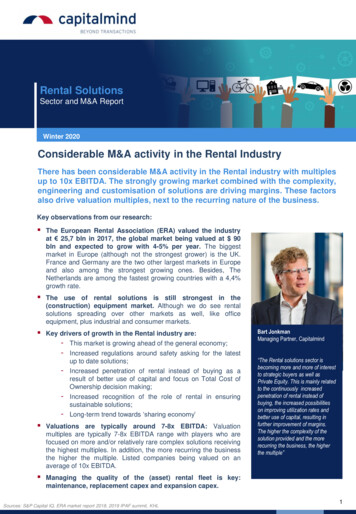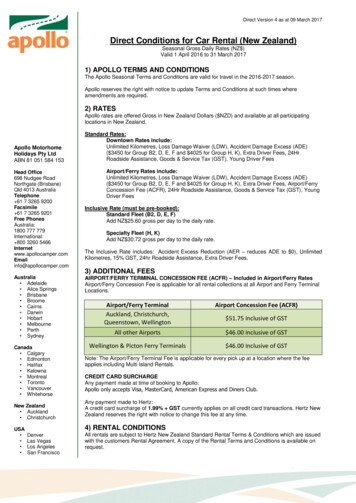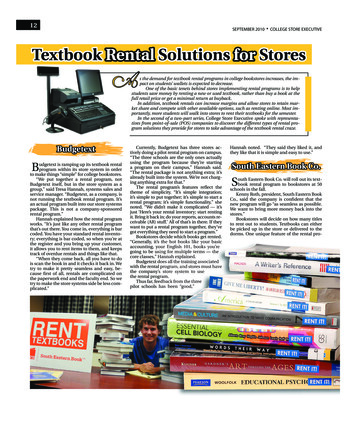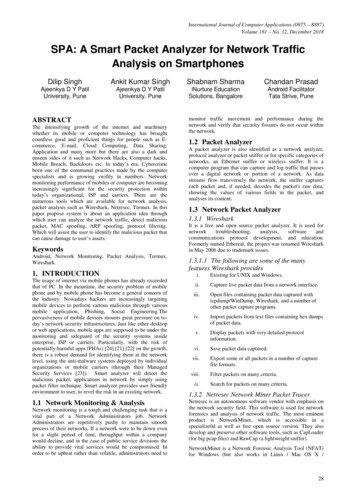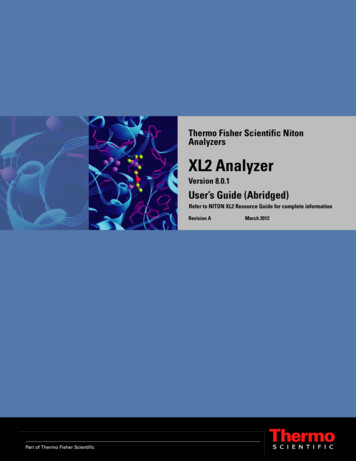
Transcription
Thermo Fisher Scientific NitonAnalyzersXL2 AnalyzerVersion 8.0.1User’s Guide (Abridged)Refer to NITON XL2 Resource Guide for complete informationRevision AMarch 2012
2010 Thermo Fisher Scientific Inc. All rights reserved.
Thermo Fisher Scientific Inc. provides this document to its customers with a product purchase to use in theproduct operation. This document is copyright protected and any reproduction of the whole or any part of thisdocument is strictly prohibited, except with the written authorization of Thermo Fisher Scientific Inc.The contents of this document are subject to change without notice. All technical information in thisdocument is for reference purposes only. System configurations and specifications in this document supersedeall previous information received by the purchaser.Thermo Fisher Scientific Inc. makes no representations that this document is complete, accurate or errorfree and assumes no responsibility and will not be liable for any errors, omissions, damage or loss that mightresult from any use of this document, even if the information in the document is followed properly.This document is not part of any sales contract between Thermo Fisher Scientific Inc. and a purchaser. Thisdocument shall in no way govern or modify any Terms and Conditions of Sale, which Terms and Conditions ofSale shall govern all conflicting information between the two documents.Release history:For Research Use Only. Not for use in diagnostic procedures.
ContentsThermo ScientificChapter 0Contact Us. . . . . . . . . . . . . . . . . . . . . . . . . . . . . . . . . . . . . . . . . . . . . . . . . . . . . . . . . . . . .1Chapter 1Manual Overview . . . . . . . . . . . . . . . . . . . . . . . . . . . . . . . . . . . . . . . . . . . . . . . . . . . . . .1Warnings, Cautions, and Notes. . . . . . . . . . . . . . . . . . . . . . . . . . . . . . . . . . . . . . 1Figures. . . . . . . . . . . . . . . . . . . . . . . . . . . . . . . . . . . . . . . . . . . . . . . . . . . . . . . . . 1Physical Buttons . . . . . . . . . . . . . . . . . . . . . . . . . . . . . . . . . . . . . . . . . . . . . . . . . 2Other Hardware . . . . . . . . . . . . . . . . . . . . . . . . . . . . . . . . . . . . . . . . . . . . . . . . . 2Chapter 2Using Your Analyzer . . . . . . . . . . . . . . . . . . . . . . . . . . . . . . . . . . . . . . . . . . . . . . . . . . . .3Safely and Effectively Using Your Analyzer . . . . . . . . . . . . . . . . . . . . . . . . . . . . . 3Proper and Improper Operation . . . . . . . . . . . . . . . . . . . . . . . . . . . . . . . . . . . . 19Chapter 3How to Analyze . . . . . . . . . . . . . . . . . . . . . . . . . . . . . . . . . . . . . . . . . . . . . . . . . . . . . . .23General Analysis . . . . . . . . . . . . . . . . . . . . . . . . . . . . . . . . . . . . . . . . . . . . . . . . 24Chapter 4Basic Operation. . . . . . . . . . . . . . . . . . . . . . . . . . . . . . . . . . . . . . . . . . . . . . . . . . . . . . .29Taking a Sample Analysis . . . . . . . . . . . . . . . . . . . . . . . . . . . . . . . . . . . . . . . . . 29Analysis Modes . . . . . . . . . . . . . . . . . . . . . . . . . . . . . . . . . . . . . . . . . . . . . . . . . 37Chapter 5Common Operations . . . . . . . . . . . . . . . . . . . . . . . . . . . . . . . . . . . . . . . . . . . . . . . . . . .47Metal Sample Prep . . . . . . . . . . . . . . . . . . . . . . . . . . . . . . . . . . . . . . . . . . . . . . 47Soil Sample Prep . . . . . . . . . . . . . . . . . . . . . . . . . . . . . . . . . . . . . . . . . . . . . . . . 60Preparing Mining Samples . . . . . . . . . . . . . . . . . . . . . . . . . . . . . . . . . . . . . . . . 64Setting Up Beep Times . . . . . . . . . . . . . . . . . . . . . . . . . . . . . . . . . . . . . . . . . . . 65Sorting the Custom Element Display . . . . . . . . . . . . . . . . . . . . . . . . . . . . . . . . 66Max Measure Time . . . . . . . . . . . . . . . . . . . . . . . . . . . . . . . . . . . . . . . . . . . . . . 67Minumum Test Time . . . . . . . . . . . . . . . . . . . . . . . . . . . . . . . . . . . . . . . . . . . . 67Virtual Keyboard . . . . . . . . . . . . . . . . . . . . . . . . . . . . . . . . . . . . . . . . . . . . . . . . 68Setting Display Units . . . . . . . . . . . . . . . . . . . . . . . . . . . . . . . . . . . . . . . . . . . . 71Adjusting the Element Range . . . . . . . . . . . . . . . . . . . . . . . . . . . . . . . . . . . . . . 73Setting the Date and Time . . . . . . . . . . . . . . . . . . . . . . . . . . . . . . . . . . . . . . . . 74Calibrating the Touch Screen . . . . . . . . . . . . . . . . . . . . . . . . . . . . . . . . . . . . . . 81Chapter 6Data Management. . . . . . . . . . . . . . . . . . . . . . . . . . . . . . . . . . . . . . . . . . . . . . . . . . . . .83Viewing Data . . . . . . . . . . . . . . . . . . . . . . . . . . . . . . . . . . . . . . . . . . . . . . . . . . 83Viewing Fingerprints . . . . . . . . . . . . . . . . . . . . . . . . . . . . . . . . . . . . . . . . . . . . . 90Erasing Data . . . . . . . . . . . . . . . . . . . . . . . . . . . . . . . . . . . . . . . . . . . . . . . . . . . 91Managing Libraries . . . . . . . . . . . . . . . . . . . . . . . . . . . . . . . . . . . . . . . . . . . . . . 96Chapter 7Connectivity . . . . . . . . . . . . . . . . . . . . . . . . . . . . . . . . . . . . . . . . . . . . . . . . . . . . . . . . .103Using Your Analyzer With Your PC . . . . . . . . . . . . . . . . . . . . . . . . . . . . . . . . 109Connecting From Your Analyzer to Your PC . . . . . . . . . . . . . . . . . . . . . . . . . 111Using a USB Cable to Connect Your Analyzer . . . . . . . . . . . . . . . . . . . . . . . . 114Downloading Data . . . . . . . . . . . . . . . . . . . . . . . . . . . . . . . . . . . . . . . . . . . . . 116manual-name1
Contents2manual-nameChapter 7Controlling Your Analyzer From Your PC . . . . . . . . . . . . . . . . . . . . . . . . . . . . . . . .125Chapter 8Learning More, Service, and Support . . . . . . . . . . . . . . . . . . . . . . . . . . . . . . . . . . .129Replacing the Measurement Window . . . . . . . . . . . . . . . . . . . . . . . . . . . . . . . 129Tips and Troubleshooting . . . . . . . . . . . . . . . . . . . . . . . . . . . . . . . . . . . . . . . . 132Storing and Transporting Your Niton XL2 Analyzer . . . . . . . . . . . . . . . . . . . . 139Chapter 8Advanced Settings . . . . . . . . . . . . . . . . . . . . . . . . . . . . . . . . . . . . . . . . . . . . . . . . . . .143Tools Menu Options. . . . . . . . . . . . . . . . . . . . . . . . . . . . . . . . . . . . . . . . . . . . 149NDF Files: User Data Structuring . . . . . . . . . . . . . . . . . . . . . . . . . . . . . . . . . . 169Safety Settings . . . . . . . . . . . . . . . . . . . . . . . . . . . . . . . . . . . . . . . . . . . . . . . . . 181Camera . . . . . . . . . . . . . . . . . . . . . . . . . . . . . . . . . . . . . . . . . . . . . . . . . . . . . . 188Chapter 8Service . . . . . . . . . . . . . . . . . . . . . . . . . . . . . . . . . . . . . . . . . . . . . . . . . . . . . . . . . . . . .191Warranty . . . . . . . . . . . . . . . . . . . . . . . . . . . . . . . . . . . . . . . . . . . . . . . . . . . . . 191Thermo Scientific
Contact hermofisher.com1
02Contact UsNiton XL2 Analyzer User’s GuideThermo Scientific
1 Manual OverviewWarnings, Cautions, and NotesManual OverviewWarnings, Cautions, and NotesWarningsWarnings are extremely important recommendations, violating which may result in eitherinjury to yourself or others, or damage to your analyzer and/or data. Warnings will always beidentified as Warnings in the text, and will always be visually presented as follows:WARNING This is a Warning.Example Warning:WARNING Tampering with the 5,500 ppm (Lead high) lead-in-soil standard may causeexposure to lead dust. Keep all standards out of reach of children.CautionsCautions are important recommendations. Cautions will always be identified as Cautions inthe text, and will always be visually presented as follows:CAUTION This is a Caution.Example Caution:CAUTION Never tamper with Test Standards. They should not be used unless they arecompletely intactNotesNotes are informational asides which may help you with your analyses. Notes will always beidentified as Notes in the text, and will always be visually presented as follows:Note This is a Note.Example Note:Note For defensible Quality Control, keep a record of the time and precision of everycalibrationFiguresFigures are illustrations used to show what something looks like. Figures will always belabelled and identified as Figures directly below the Figure itself, and will always be visuallypresented as follows:Thermo ScientificNiton XL2 Analyzer User’s Guide1
1 Manual OverviewPhysical ButtonsFigure 1.This is a FigurePhysical ButtonsPhysical Buttons are actual buttons on the analyzer which must be pushed to activate theirfunction. Physical Buttons will always be identified as Buttons in the text, and will always bevisually presented as follows:This is a Physical Button.Example Physical Buttons:On/Off/Escape Button, Clear/Enter Button, Interlock Button, and Trigger Button.Other HardwareOther Hardware refers to any physical part of the analyzer which performs a necessaryfunction. Other Hardware will always be visually presented as follows:This is an example of Other Hardware.Example Other Hardware:Battery, Touch Screen Display, Measurement Window, and USB Cable2Niton XL2 Analyzer User’s GuideThermo Scientific
Using Your AnalyzerThis section discusses the basics of using your analyzer, no matter thespecific type of analysis you wish to perform. First we go over analyzersafety, particularly radiation safety. Using an X-ray based analyzer safelyis very important, and not difficult, provided you read, understand, andfollow these guidelines. Secondly, we outline the startup procedure werecommend for daily use to ensure that your analyzer is performingproperly and at its most efficient level.Safely and Effectively Using Your AnalyzerCAUTION Niton analyzers are not intrinsically safe analyzers. Allpertinent Hot Work procedures should be followed in areas of concern.WARNING Always treat radiation with respect. Do not hold youranalyzer near the measurement window during testing. Never point youranalyzer at yourself or anyone else when the shutter is open.Radiation and General SafetyThis section covers topics related to radiation safety and general safetywhen using a Thermo Scientific Niton XL2 analyzer. At a minimum alloperators of the analyzer should be familiar with the instructionsprovided in this chapter in order to handle the analyzer in a safe manner.In addition to reading the information presented on the following pages,Thermo Fisher Scientific recommends that instrument users participatein a radiation safety and operational training class.Radiation Protection BasicsThe Niton Model XL2 analyzer contains an x-ray tube which emitsradiation only when the user turns the x-ray tube on. When the x-raytube is on and the shutter is open, as during a measurement, the analyzeremits a directed radiation beam - see Figures 1-1 and 1-2. Reasonableeffort should be made to maintain exposures to radiation as far belowdose limits as is practical. This is known as the ALARA (As Low asReasonably Achievable) principle. For any given source of radiation,three factors will help minimize your radiation exposure: Time,Distance, and Shielding.3
2 Using Your AnalyzerSafely and Effectively Using Your AnalyzerTimeThe longer you are exposed to a source of radiation the longer the radiation is able to interactin your body and the greater the dose you receive. Dose increases in direct proportion tolength of exposure.DistanceThe closer you are to a source of radiation, the more radiation strikes you. Basedon geometry alone, dose increases and decreases with an inverse-squared relationto your distance from the source of radiation (additional dose rate reduction comesfrom air attenuation). For example, the radiation dose one foot from a source isnine times greater than the dose three feet from the source. Remember to keep yourhands and all body parts away from the front end of the analyzer when the shutteris open to minimize your exposure.ShieldingShielding is any material that is placed between you and the radiation source. The morematerial between you and the source, or the denser the material, the less you will be exposedto that radiation. Supplied or optional test stands are an additional source of shielding foranalysis. A backscatter shield accessory is also available and may be appropriate in someapplications.Exposure to RadiationHuman dose to radiation is typically measured in rem, or in one-thousandths of a rem, calledmillirem (mrem), 1 rem 1000 mrem. Another unit of dose is the Sievert (Sv), 1 Sv 100rem. The allowable limit for occupational exposure in the U.S (and many other countries) is5,000 mrem/year (50 mSv/year) for deep (penetrating) dose and 50,000 mrem/year (500mSv/year) for shallow (i.e., skin) dose or dose to extremities. Deep, shallow, and extremityexposure from a properly used Niton XL2 analyzer should be less than 200 mrem per year,(2.0 mSv per year) even if the analyzer is used as much as 2,000 hours per year, with theshutter open continuously. The only anticipated exceptions to the 200 mrem maximumannual dose are: 1) routine and frequent analysis of plastic samples without use of a test stand,backscatter shield, or similar additional protective measures, or 2) improper use where a partof the body is in the primary beam path.Note NEVER OPERATE THE DEVICE WITH A PART OF YOUR BODY IN THEPRIMARY BEAM PATH OR WITH THE PRIMARY BEAM PATH DIRECTED ATANYONE ELSE.Also, consider the use of protective accessories such as a shielded test stand or backscattershield (or equivalent) when performing routine and/or frequent analysis of any of thefollowing:4Niton XL2 Analyzer User’s GuideThermo Scientific
2 Using Your AnalyzerSafely and Effectively Using Your Analyzer light materials (such as plastic, wood, or similarly low density/low atomic masssamples) thin samples (such as foils, circuit boards, and wires) samples that are smaller than the analysis window.Shown in Table 1 are the typical background radiation doses received by the average memberof the public. The radiation dose limits for radiation workers in the US are also shown inTable 2.Thermo ScientificNiton XL2 Analyzer User’s Guide5
2 Using Your AnalyzerSafely and Effectively Using Your AnalyzerTable 1. Typical Radiation Doses Received (Source: NCRP 1987)CategoryDose in mremDose in mSvAverage total dose in US (annual)Average worker exposure (annual)Average exposure for an undergroundminerExposure for airline crew (1,000 hours at35,000 ft)Additional from living in Denver at 5300’(annual)Additional from 4 pCi/l radon in home3602104003.62.14.05005.025.251,00010.0Typical Chest X-RayTypical Head or Neck X-RayTypical pelvis/hip x-rayTypical lumbar spine x-ray62065300.060.20.650.3Typical Upper G.I. x-rayTypical Barium enema x-rayTypical CAT scan2454051102.454.051.10Table 2.6Annual Occupational Dose Limits for Radiation Workers (Source:Code of Federal Regulations Title 10, Part 20)CategoryDose in mremDose in mSvWhole BodyPregnant Worker (during gestationperiod)Eye Dose EquivalentShallow dose equivalent to the skin orany extremity or organMaximum allowable dose for the generalpublic (annual)For a Minor500050050515,00050,0001505001001.05005.0Niton XL2 Analyzer User’s GuideThermo Scientific
2 Using Your AnalyzerSafely and Effectively Using Your AnalyzerMonitoring your radiation exposureIndividuals can be monitored for the radiation dose they receive by use of radiation dosimetrydevices (dosimeters). Monitoring dose using a dosimeter can be a way of identifying improperuse and at the same time demonstrating proper use. In some locations, dosimetry is requiredby regulations and in others it is optional. It is normally required when the user couldreasonably be expected to receive in excess of 10% of the annual dose limit. Thermo FisherScientific recommends that you determine and obey the local regulatory requirementsconcerning radiation monitoring of occupational workers.Two common types of dosimeters are whole-body badges and ring badges. Whole bodybadges are often attached to the user’s torso (e.g., clipped to the collar, shirt pocket, or waist asappropriate). A ring badge is worn on the finger as a measure of maximum extremity dose.When worn, the specific location of the dosimeter should be that part of the body that isexpected to receive the highest dose. This location will depend on how the analyzer is usedand so it may not be the same for all users. Dosimetry services are offered by many companies.Two companies offering dosimetry services in the USA and much of the world are:CompanyGlobal Dosimetry SolutionsLandauer, Inc.Address2652 McGaw Avenue2 Science RoadCity and StateIrvine, CA 92614Glenwood, IL comPhone Number(800) 251-3331(800) 323-8830Note Wearing a dosimeter badge does not protect you against radiation exposure. Adosimeter badge only measures your exposure (at the dosimeter location).Pregnancy and Radiation ExposureInternational guidance documents (e.g., ICRP Publication 60 and NCRP Publication 116*)recommend that the radiation dose to the embryo/fetus of a pregnant woman should notexceed a total of 500 mrem (10% of normal radiation worker limit) during the gestationperiod. While this dose limit exceeds the dose limit to a trained operator, pregnant workersmay want to take special precautions to reduce their exposure to radiation. For moreinformation see the U.S. NRC Regulatory Guide 8.13 "Instruction Concerning PrenatalRadiation Exposure" which can be found on the resource CD.* The International Commission on Radiological Protection, ICRP, is an independentRegistered Charity, established to advance for the public benefit the science of radiologicalprotection, in particular by providing recommendations and guidance on all aspects ofprotection against ionizing radiation.Thermo ScientificNiton XL2 Analyzer User’s Guide7
2 Using Your AnalyzerSafely and Effectively Using Your Analyzer* The National Council on Radiation Protection and Measurements (NCRP) was charteredby the U.S. Congress in 1964 as the National Council on Radiation Protection andMeasurements.How to Use the Niton XL2 Analyzer SafelyThe Niton XL2 analyzer is designed to be safe to operate provided that it is used inaccordance with manufacturer's instructions. Under conditions of normal use, monitoredoperators seldom receive a measurable dose and have not been known to receive in excess of10% of the annual occupational dose limits (a criteria that would require monitoring underregulation in the U.S.). In addition to proper use of the analyzer, it is recommended that youfollow these precautions to ensure your safety and the safety of those around you.Know where the beam isThe primary beam is a directed beam out of the front of the analyzer that can have high doserates. The secondary beam, or scattered beam, has much lower dose rates.Figure 1.8Niton XL2 Analyzer User’s GuidePrimary BeamThermo Scientific
2 Using Your AnalyzerSafely and Effectively Using Your AnalyzerFigure 2.Secondary (Scattered) BeamThe Shutter-Open Indicator LightsWhen the lights are flashing, the primary beam is on, and radiation is being emitted from thefront of the analyzer.Figure 3.Thermo ScientificThe X-ray Beam Indicator LightsNiton XL2 Analyzer User’s Guide9
2 Using Your AnalyzerSafely and Effectively Using Your AnalyzerHandle and Use with RespectAvoid holding the front of the analyzer when the x-ray tube is energized and the shutter isopen. Never point the instrument at yourself or anyone else when the shutter is open and thex-ray tube is energized. Never look into the path of the primary beam.Follow a Radiation Protection ProgramYour organization should establish, document, and follow a Radiation Protection Program.An example of such a program can be found on the resource CD (provided with theinstrument).Take Proper Care of your Niton XL2Keeping your analyzer maintained in good condition will help minimize the risk of accidentalexposure. Mechanical malfunction of the shutter can be avoided by maintaining themeasurement window, as described in the User Guide. This prevents foreign objects fromentering your analyzerAvoid Over-ExposuresDirect contact with the window could result in overexposures in the times indicated inTable 3below.Table 3. Potential Exposure Limit TimesLocation of DoseLimitDeep Dose /5 rem (50 mSv)Whole BodyShallow Dose /50 rem (500 mSv)ExtremitiesMember of Public 0.1 to 5 rem (1 to 50 mSv)(i.e. untrainedoperator)Time to Reach Limit2.1 minutes0.95 minutes2.5 to 9.5 secondsExtremity is defined by the NRC as the hand, elbow, arm below the elbow, foot, knee, or legbelow the knee. Whole Body is defined by the NRC as the head, trunk (including malegonads), arms above the elbow, or legs above the knee.Safe Handling of SamplesAs mentioned many times in this chapter, never place any part of your body in the path of thex-ray beam. There is always a safe way to handle samples whether they are small, irregularlyshaped, or of low density. Never look into the path of the primary beam.10Niton XL2 Analyzer User’s GuideThermo Scientific
2 Using Your AnalyzerSafely and Effectively Using Your AnalyzerSmall SamplesA small sample would be any sample that is smaller than the measurement window. Smallsamples present a unique risk because they don’t block the entire beam path. The difficultywith placing small samples down on a work surface to analyze them is that you may getreadings from the work surface that interfere with analytical results. A test stand is an effectiveway of analyzing small samples accurately and safely. Never hold samples during analysis orlook into the path of the primary beam.Irregularly Shaped SamplesIrregularly shaped samples may not allow the proximity button to be depressed, or they maynot entirely cover the primary beam and cause additional scattering. A back scatter shield is asafe way of reducing your radiation exposure while effectively analyzing an irregularly shapedsample.Light Materials (such as plastics).X-rays are attenuated more by denser and higher atomic mass materials, and less throughlighter materials such as plastic. This causes higher dose rates in the scattered radiation. If youare frequently handling low density samples, you should consider the use of test stands,backscatter shields, or the equivalent.Thermo ScientificNiton XL2 Analyzer User’s Guide11
2 Using Your AnalyzerSafely and Effectively Using Your AnalyzerNiton XL2 Radiation ProfileRadiation Meter InformationModel: Bicron MicroRemSN: 2057Cal Due: 10/10/2009Background Radiation Level 0.01 mr/hrTable 4 - Scatter Measurements off various substrates - Dose Rates in mRem/hrTable 4. Niton XL2 Radiation Profile - Scatter Measurements - mRem/hr12kVuARangeSubstrateMax @ 5cmMax @ 30 cmMax @ Trigger1580LowAluminum 0.01 0.01 0.011580LowStainless 0.01 0.01 0.011580LowPlastic 0.01 0.01 0.011580LowSoil 0.01 0.01 0.012080LowAluminum 0.01 0.01 0.012080LowStainless 0.01 0.01 0.012080LowPlastic3 0.01 0.012080LowSoil 0.01 0.01 .6 0.01 025Niton XL2 Analyzer User’s GuideThermo Scientific
2 Using Your AnalyzerSafely and Effectively Using Your AnalyzerTable 5 - Scatter Measurements off various substrates - Dose Rates in µSv/hrTable 5. Niton XL2 Radiation Profile - Scatter Measurements - µSv/hrkVuARangeSubstrateMax @ 5cmMax @ 30 cmMax @ Trigger1580LowAluminum 0.1 0.1 0.11580LowStainless 0.1 0.1 0.11580LowPlastic 0.1 0.1 0.11580LowSoil 0.1 0.1 0.12080LowAluminum 0.1 0.1 0.12080LowStainless 0.1 0.1 0.12080LowPlastic30 0.1 0.12080LowSoil 0.1 0.1 0.14544MainAluminum120.170.14544MainStainless16 0.1 tes:Scatter measurements were taken at a radius of 5 or 30 cm around the nose of the analyzerwith the highest scatter dose rate being recorded.Thermo ScientificNiton XL2 Analyzer User’s Guide13
2 Using Your AnalyzerSafely and Effectively Using Your AnalyzerTable 6 - In Beam Measurements - Dose Rates in Rem/hrTable 6. Niton XL2 Radiation Profile - In Beam Measurements - Rem/hrkVuARangeContact DeepContact Shallow5cm Deep30cm n451507.40.70Table 7 - In Beam Measurements - Dose Rates in mSv/hrTable 7. Niton XL2 Radiation Profile - In Beam Measurements - mSv/hrkVuARangeContact DeepContact Shallow5cm Deep30cm n4501500747.0Notes:In beam dose rates were measured using optically stimulated luminescent (OSL) dosimeters.Reported results are based on measurement results that have been reduced to 2 significantdigits by rounding up. For example, a measurement result of 1441 would be reported as1500.14Niton XL2 Analyzer User’s GuideThermo Scientific
2 Using Your AnalyzerSafely and Effectively Using Your AnalyzerNiton XL2 GOLDD Radiation ProfileTable 8 - Niton XL2 GOLDD Radiation profile- Scatter measurements - mRem/hrTable 8. Niton XL2 GOLDD Radiation Profile - Scatter Measurements - mRem/hrkVuARangeSubstrateMax @ 5cmMax @ 30 cmMax @ Trigger8100LightPlastic 0.01 0.01 0.018100LightStainless 0.01 0.01 0.018100LightSoil 0.01 0.01 0.014544.4 MainAluminum0.5 0.01 0.014544.4 MainStainless0.01 0.01 0.014544.4 MainPlastic5.00.40.84544.4 MainSoil0.9 0.01 0.01Table 9 - Niton XL2 GOLDD Radiation Profile - Scatter Measurements - µSv/hrTable 9. Niton XL2 GOLDD Radiation Profile - Scatter Measurements - µSv/hrkVuARangeSubstrateMax @ 5cmMax @ 30 cmMax @ Trigger8100LightPlastic 0.1 0.1 0.18100LightStainless 0.1 0.1 0.18100LightSoil 0.1 0.1 0.14544.4 MainAluminum5.0 0.1 0.14544.4 MainStainless0.1 0.1 0.14544.4 MainPlastic504.08.04544.4 MainSoil9.0 0.1 0.1Notes:Scatter measurements were taken at a radius of 5 or 30 cm around the nose of the analyzerwith the highest scatter dose rate being recorded.Thermo ScientificNiton XL2 Analyzer User’s Guide15
2 Using Your AnalyzerSafely and Effectively Using Your AnalyzerTable 10 - Niton XL2 GOLDD Radiation Profile - In Beam Measurements - Rem/hrTable 10. Niton XL2 GOLDD Radiation Profile - In Beam Measurements - Rem/hrkVuA845RangeContact DeepContact Shallow5cm Deep30 cm Deep100 Light0.019800.002 0.00144.4 Main391308.10.51Table 11 - Niton XL2 GOLDD Radiation Profile - In Beam Measurements - mSv/hrTable 11. Niton XL2 GOLDD Radiation Profile - In Beam Measurements - mSv/hrkVuA845RangeContact DeepContact Shallow5cm Deep30 cm Deep100 Light0.198000.02 0.0144.4 Main3901300815.1Notes:In beam dose rates were measured using optically stimulated luminescent (OSL) dosimeters.Reported results are based on measurement results that have been reduced to 2 significantdigits by rounding up. For example, a measurement result of 1441 would be reported as1500.16Niton XL2 Analyzer User’s GuideThermo Scientific
2 Using Your AnalyzerSafely and Effectively Using Your AnalyzerFigure 4.Thermo ScientificPrimary and Secondary Dose Locations (Not to Scale)Niton XL2 Analyzer User’s Guide17
2 Using Your AnalyzerSafely and Effectively Using Your AnalyzerPrimary RadiationPrimary radiation is radiation that is produced by the analyzer and emitted out through thekapton measurement window. Individuals should never place any part of their body in theprimary beam path when the x-ray tube is on. There should always be a sample in contactwith the measurement window when the x-ray tube is on. The sample will absorb most of theprimary-beam radiation unless it is smaller than the instrument's measurement window or oflow atomic mass, low density, and/or very thin. Caution should be taken when analyzingsamples that are small, thin, and/or low in atomic mass or density as they may allow muchmore of the primary beam to escape. In-beam primary radiation dose rates for the Niton XL2are listed in Table 6 andTable 7 - or Table 10 and Table 11 for the Niton XL2 GOLDD - andtheir location identified relative to the analyzer in Figure 4 as Dose Point C.Secondary RadiationUnder conditions of normal and proper use, individuals can be exposed to secondary (or"scattered") radiation. Secondary radiation is low-level radiation that emanates from thesample being analyzed as a result of primary beam radiation scattering in the sample orprimary beam radiation inducing fluorescent x-rays in the sample. Dose points A, A’ and B inFigure 4 are examples of where you can encounter secondary radiation. The magnitude of thissecondary radiation is sample dependent. Higher atomic mass and density samples such assteel will emit the lowest levels as they absorb most primary and secondary radiations. Loweratomic mass and density samples such as aluminum, wood, and especially plastic, will producehigher levels of secondary radiation. Secondary radiation dose rates for the Niton XL2 arelisted in Table 4 and Table 5 - or Table 8 and Table 9 for the Niton XL2 GOLDD - for a fewcommon sample types over a wide range of densities.The operator is reminded that one should never hold samples during analysis, doing so willresult in higher than necessary exposure to secondary radiation and could expose the operatordirectly to the much higher primary-beam dose rates.Deep and Shallow DoseYou will find in Table 6, Table 7, Table 10, and Table 11 that shallow dose rates are listed forsome dose points. All dose rates listed in these four Tables are deep dose unless they arespecifically identified as shallow dose. Deep dose is dose from penetrating radiation that isdelivered to both skin and underlying tissues and organs and is the type most commonlyreferred to when describin
1 Manual Overview Physical Buttons 2 Niton XL2 Analyzer User's Guide Thermo Scientific Figure 1. This is a Figure Physical Buttons Physical Buttons are actual buttons on the analyzer which must be pushed to activate their function. Physical Buttons will always be identified as Buttons in the text, and will always be



